Book contents
- The Cambridge Handbook of Corrective Feedback in Second Language Learning and Teaching
- Cambridge Handbooks in Language and Linguistics
- The Cambridge Handbook of Corrective Feedback in Second Language Learning and Teaching
- Copyright page
- Contents
- Figures
- Tables
- Contributors
- Acknowledgments
- Introduction Corrective Feedback in Second Language Teaching and Learning
- Part I Theoretical Perspectives on Corrective Feedback
- Part II Methodological Approaches in the Study of Corrective Feedback
- Part III Different Delivery Modes of Corrective Feedback
- Part IV Feedback Provider, Feedback Intensity, and Feedback Timing
- 13 Peer Feedback in Second Language Oral Interaction
- 14 Focused versus Unfocused Corrective Feedback
- 15 Corrective Feedback Timing and Second Language Grammatical Development: Research, Theory, and Practice
- 16 Explicit and Implicit Oral Corrective Feedback
- Part V Corrective Feedback and Language Skills
- Part VI Contexts of Corrective Feedback and Their Effects
- Part VII Learners’ and Teachers’ Feedback Perspectives, Perceptions, and Preferences
- Part VIII Individual Differences, Tasks, and Other Language- and Learner-Related Factors
- Index
- References
14 - Focused versus Unfocused Corrective Feedback
from Part IV - Feedback Provider, Feedback Intensity, and Feedback Timing
Published online by Cambridge University Press: 26 February 2021
- The Cambridge Handbook of Corrective Feedback in Second Language Learning and Teaching
- Cambridge Handbooks in Language and Linguistics
- The Cambridge Handbook of Corrective Feedback in Second Language Learning and Teaching
- Copyright page
- Contents
- Figures
- Tables
- Contributors
- Acknowledgments
- Introduction Corrective Feedback in Second Language Teaching and Learning
- Part I Theoretical Perspectives on Corrective Feedback
- Part II Methodological Approaches in the Study of Corrective Feedback
- Part III Different Delivery Modes of Corrective Feedback
- Part IV Feedback Provider, Feedback Intensity, and Feedback Timing
- 13 Peer Feedback in Second Language Oral Interaction
- 14 Focused versus Unfocused Corrective Feedback
- 15 Corrective Feedback Timing and Second Language Grammatical Development: Research, Theory, and Practice
- 16 Explicit and Implicit Oral Corrective Feedback
- Part V Corrective Feedback and Language Skills
- Part VI Contexts of Corrective Feedback and Their Effects
- Part VII Learners’ and Teachers’ Feedback Perspectives, Perceptions, and Preferences
- Part VIII Individual Differences, Tasks, and Other Language- and Learner-Related Factors
- Index
- References
Summary
A question that received considerable interest from language teachers and researchers alike is what corrective feedback (CF) should look like to be maximally beneficial to learners’ second language development. This chapter zooms in on two feedback types that have been distinguished in the CF literature: focused and unfocused CF. After a careful characterization of these two feedback options, theoretical, methodological, and pedagogical arguments are discussed for both of them. The chapter furthermore provides a synthesis of oral and written feedback studies into the (relative) value of focused and unfocused CF. It concludes with suggestions for further research and implications for L2 classrooms.
Keywords
- Type
- Chapter
- Information
- The Cambridge Handbook of Corrective Feedback in Second Language Learning and Teaching , pp. 300 - 321Publisher: Cambridge University PressPrint publication year: 2021
References
- 6
- Cited by

